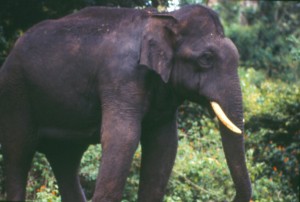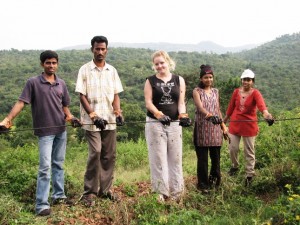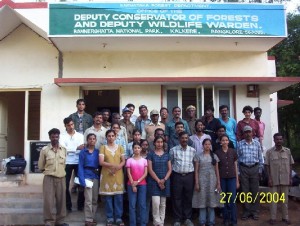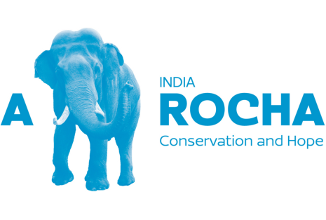Asian Elephant conservation
A small effort to save a large mammal…
 The Asian Elephant (Elephas maximus) is often considered the flagship for conservation in South and Southeast Asia. IUCN, the World Conservation Union, estimates that there are between 38 and 51 thousand wild Asian Elephants, as compared to more than 600 thousand African Elephants. That makes the population of the Asian Elephant a mere 6% to 8% of their African cousins. The world’s second largest land mammal is in urgent need of effective conservation under both national and international legislation. The Asian Elephant has been given the highest level of protection in India by its inclusion in Schedule 1 of the Indian Wildlife (Protection) Act 1972. They are also included in Appendix I of the Convention on International Trade in Endangered Species of Wild Fauna and Flora. Despite these conservation measures, the survival of the Asian Elephant continues to be threatened by fragmentation and degradation of natural habitat, poaching for ivory and human-elephant conflict.
The Asian Elephant (Elephas maximus) is often considered the flagship for conservation in South and Southeast Asia. IUCN, the World Conservation Union, estimates that there are between 38 and 51 thousand wild Asian Elephants, as compared to more than 600 thousand African Elephants. That makes the population of the Asian Elephant a mere 6% to 8% of their African cousins. The world’s second largest land mammal is in urgent need of effective conservation under both national and international legislation. The Asian Elephant has been given the highest level of protection in India by its inclusion in Schedule 1 of the Indian Wildlife (Protection) Act 1972. They are also included in Appendix I of the Convention on International Trade in Endangered Species of Wild Fauna and Flora. Despite these conservation measures, the survival of the Asian Elephant continues to be threatened by fragmentation and degradation of natural habitat, poaching for ivory and human-elephant conflict.
Human-elephant conflict refers to negative interaction between wild elephants and human beings such as crop raiding by elephants, human death and injury caused by elephants and humans killing elephants. In order to ensure the long-term survival of the Asian Elephant, it is important to identify and understand the direct and indirect threats to their survival. A Rocha India has been able to raise grant support from The Rufford Maurice Laing Foundation, UK and the US Fish and Wildlife Service to undertake a project to understand the human-elephant conflict issue since 2004. The single largest population of elephants in Asia is found in southern India in Elephant Reserve No. 7 of Project Elephant (a conservation project of the Government of India). The study area, the Bannerghatta National Park, forms part of Reserve No. 7. It covers an area of 104 km² and is situated about 20 km south of the city of Bangalore. According to a recent census of the Karnataka Forest Department, the area has around 56 elephants, living at a density of 0.54 animals per km². This is a high density, and it is not surprising that there is human-elephant conflict on the margins of the Bannerghatta National Park, which is surrounded by human settlements.
The study at the park has been attempting to:
 Assess the status of the conflict. Project workers will survey villages surrounding the Park to assess the land-use pattern and intensity of the conflict. The surveys would also try to identify possible solutions to the problem through the participation of the local community.
Assess the status of the conflict. Project workers will survey villages surrounding the Park to assess the land-use pattern and intensity of the conflict. The surveys would also try to identify possible solutions to the problem through the participation of the local community.
Study the size and structure of the elephant population. Using the latest elephant surveying techniques, the number of elephants in the study area will be assessed. The seasonal movements of elephants will be observed to determine the effectiveness of the habitat corridors and how it relates to recorded conflicts.
 Assess in detail the existing deterrents against elephant incursions test new deterrents for mitigation of the conflicts. The team is now testing a new elephant barrier at the Park; which is popularly known as the chilli-tobacco barrier, used in many parts of Africa and targets the sense of smell, which is most developed in elephants. This experiment at the Park is the first of its kind where monitoring of test plots are being undertaken in five high crop raided villages for a period of three months.
Assess in detail the existing deterrents against elephant incursions test new deterrents for mitigation of the conflicts. The team is now testing a new elephant barrier at the Park; which is popularly known as the chilli-tobacco barrier, used in many parts of Africa and targets the sense of smell, which is most developed in elephants. This experiment at the Park is the first of its kind where monitoring of test plots are being undertaken in five high crop raided villages for a period of three months.
Develop management recommendations. These are aimed at the long-term conservation of the elephant population, with a particular focus on mitigating conflicts with human communities. The team will explore various options, drawing on the advice of the Karnataka Forest Department and experts in this area, and present the results to government authorities.
 A Rocha India is greatly indebted to the Asian Elephant expert Prof R. Sukumar for his guidance, and his colleagues Mr. Thomas Mathew and Mr. Surendra Varma at the Asian Elephant Research & Conservation Centre, Bangalore, for their support from the inception of this project, with special mention of Mr Surendra Varma for input in the field. A Rocha India is also thankful to the Karnataka Forest Department for the concepts and field support being extended. The project will reflect A Rocha’s dual concern, to try and find a solution that will benefit the local people as well as wildlife.
A Rocha India is greatly indebted to the Asian Elephant expert Prof R. Sukumar for his guidance, and his colleagues Mr. Thomas Mathew and Mr. Surendra Varma at the Asian Elephant Research & Conservation Centre, Bangalore, for their support from the inception of this project, with special mention of Mr Surendra Varma for input in the field. A Rocha India is also thankful to the Karnataka Forest Department for the concepts and field support being extended. The project will reflect A Rocha’s dual concern, to try and find a solution that will benefit the local people as well as wildlife.
